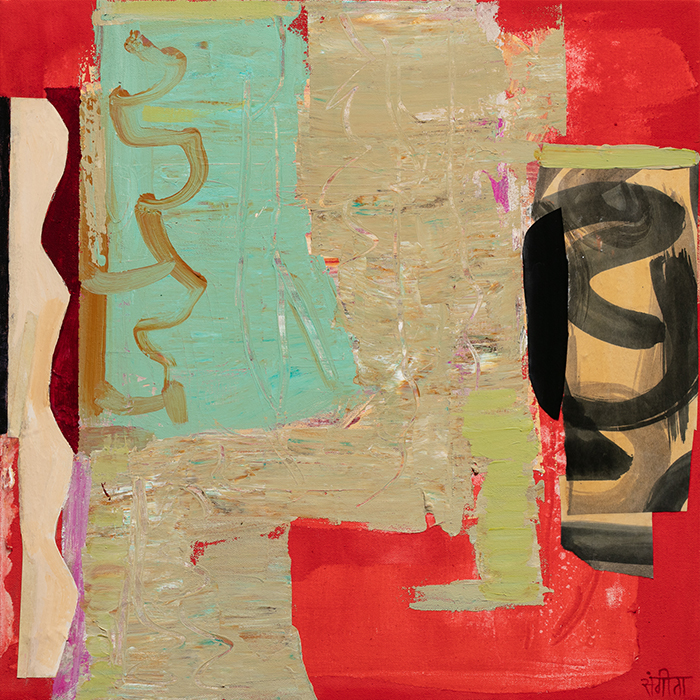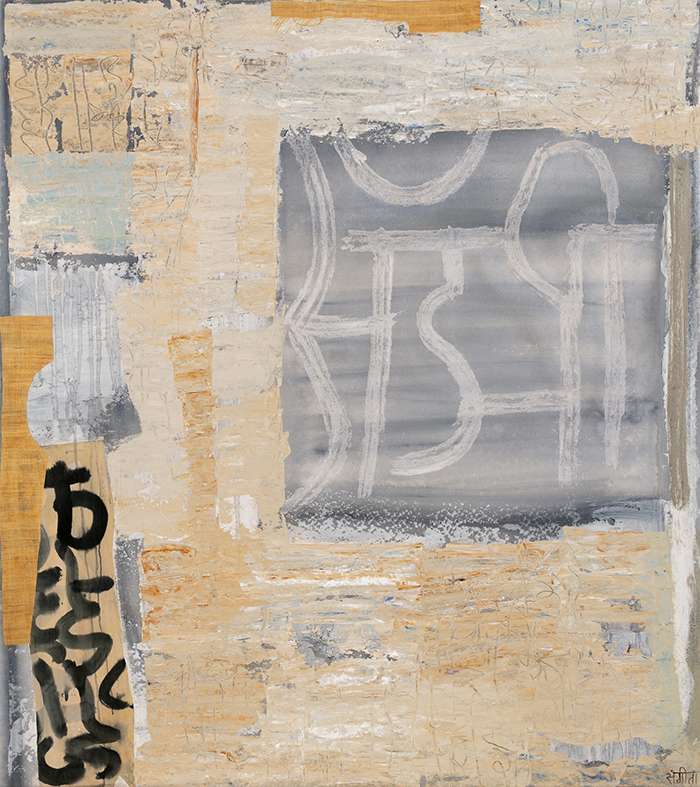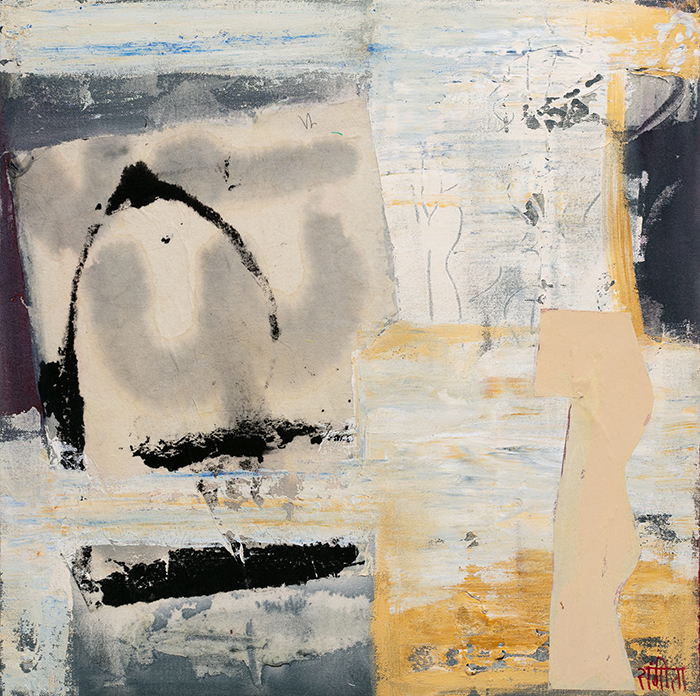Sangeeta Reddy
Artist Statement
After having worked for 28 years in an abstract expressionist manner, in November 2011, I stumbled into a new series of paintings based on the rock formations of the Colorado Plateau.
The vast and rugged rock formations that stretch over 130,000 square miles over five western states had struck awe in me from the first moment that I drove across them in the late-eighties when, as a family, we took a road trip across the high desert towards Oregon. Upon returning, I regurgitated three or four urgently felt though rudimentary landscapes in a single afternoon. All recorded my moving through that vast stillness.
I grew up in a city in southern India, on a volcanic plateau more ancient than the one upon which I now live my adult life. Compared to the precarious granite boulders of the Deccan Plateau that are the unrelenting grey of an elephant’s hide, the Colorado Plateau is characterized by dramatic scale and flagrant color. Yet in this new land, among the hills, the arroyos, the crumbling fractured rock, the semi-arid desert so reminiscent of my childhood, I felt the sharp tug on my DNA as similar to the call of home. As precarious as moving to a different continent can be, rocks are the super symbols of stability and permanence, yet they are vulnerable to the effects of the elements and the consequent erosion.
Since that first of many trips, I have become familiar with the artistic giants of the region – O’keefe, Dixon, Blumenschein, Higgins and Marin, much later of the Group of Seven and of Regionalism. They hold a high bar. Still, I cannot help but draw from the same well as they did before me – these mountains and plains, canyons and stretches of sky, pinion, sage and cottonwoods. Mostly they were in the form of small plein air works in pastel, charcoal or water color, or drawings from memory or photographs that were more reductive and expressionistic. But in the spring and summer of 2011, after many years of hiatus, I dug up some old photographs and began to revisit landscape in a sporadic but more exploratory fashion.
It was later that year, having cleared my studio of work for a show in New Delhi that I gave myself six weeks, to see what would emerge. I prepared ten or fifteen panels and small canvases (I had some precious linen canvas from the studio of the late Dale Chisman after all that I needed to try out), so if I gained momentum I would not need to stop. From mixed media, collage and acrylic I changed to oil.
Among my ‘artifacts’ from in and around Ghost Ranch in Abiquiui I found a skeletal sketch of rock and hill formations. It was an innocuous starting point. But with each little canvas, it dawned on me that I was not just making a more cohesive body of what I had previously done, but that sparks of previously unimagined impulses were emerging. Each new painting revealed additional layers to explore. After several small paintings, things began to click into place, and by the end of the allotted six weeks, cohesive threads and building blocks became apparent. There was no question in my mind that I would return from my show in India eager to commit the future to the possibilities.
In my studio at Space, I went up from 12”x16” canvases to 60”x120” inches. Preaently in my home studio amongst the rocks in Ken Caryl, I focus my work on the area just behind the Front Range where giant red rocks angle out from the low green mountains – Red Rocks Park and Amphitheater, Morrison, Ken Caryl, Arrowhead and Garden of the Gods. After working on a culminating painting of the Red Rocks Amphitheater, I spent the summer making small drawings; early this year, “Winter Rocks”. My purpose remains to convert the present stillness of these vast lands into dynamic and lyrical movement while trying to retain their latent power and poetic mystery.
Statement for the “Ellipse” series:
Life cycles have a way of re-occurring. Only, they never return in perfect circles, but in wobbly, misshapen ellipses, unexpectedly, unpredictably, and yet with a certain rhythm. The shape has always been present in my work from the earliest tentative explorations into abstract shapes.
Monotypes are everything that is direct, spontaneous, unexamined, unbidden, and confident, gushing on their own, in that moment when creating is merely a channel for something beyond the conscious. The collage is everything the monotype is not: thoughtful, considered and meandering; it is what seeps quietly beneath the surface, conscious and aware. But above all, it is the thinnest of skins – fragile, absorbent and tenacious.
For this new body of work that I have come to think of the ellipse series, I worked back into the monotypes. In a careful, deliberative process, I laid down thin skins of tissue, of paper, of cloth, making marks, erasing, red-defining, re-aligning, sometimes with charcoal and paint, sometimes thick, sometimes, thin; transparent and opaque. The more I concealed, the more what was revealed became mysterious and charged. To heighten the contemplative quality of these collages, I superimposed a neutral palette on the vivid inks and active surface of the underlying monotype.
Statement 2009:
(last modified in 2013 but pertaining to the origin of imagery in my earliest work, the Mantra series)
Despite my training in representational images, I had to leave the familiar territory of the figure, the still life, the landscape when I began to search for visual equivalents of certain intriguingly abstract ideas of Indian philosophy in the concept of “Brahman”, which is the idea of a sort of universal matrix that defies both description and limitation.
the understanding of which can be only arrived at by removing everything else. An idea of an entity from which everything emanates, to which everything returns, but which is not limited to any of the things that come from it.
Just as the layers must be peeled away to reveal the truth, I too had to shed what I had learnt and start from the beginning. I built images from their simplest forms and came up with an ellipse that contained weight and yet floated, on a background that was of ambiguous depth seemed to have a watery presence, in shapes that were either vertical (to suggest a sense of rising), but more often squarish forms that did not push or pull in any one direction so that the container did not impose itself and its boundaries on the contained.
I turned my attention to the ancient sound of chants, and began to incorporate automatic writing, specifically in the Devnagari script (Sanskrit), the language of the chants. Other visual elements came into the work – I added torn paper, textiles and filled out the layered forms which in turn became more icon-like.
Today my primary interest lies in the formal language of visual expression as it is carried forward by the thrust or incisiveness of line, by the thickness of texture, by the resonance of color, by the acrobatic precision of balance, by the still ambiguities of negative space, the contrasts between transparency and opacity, and by the juiciness or spareness of ink, much like a symphonic piece of music exists in its own linguistic context without the need of words.
It’s within the layered and nuanced relationships between elements such as these, that I look each time for the elusive presence of beauty.
Visit Sangeeta Reddy’s Official Website http://sangeetareddyart.com/
Artist Bio
Born in1955, Hyderabad, India, painter and writer Sangeeta Reddy migrated to the United States in 1978 and continued her studies in art. Currently she maintains a studio on Santa Fe Dr. in Denver, Colorado and Hyderabad, India, dividing her time between the two. She has been represented by various galleries in Aspen, Denver, New York, New Delhi, Chennai and now, Hyderabad since the beginning of her 26 year career.
Sangeeta has lived and breathed the arts from a very young age – her maternal grandmother was a contemporary of the classical vocalist Kesarbai Kerkar, her grandfather a connoisseur of the arts. Steeped in music, her mother was one of the first disciples of the late Pandit Ravi Shankar. Her late father was a pictorial photographer who co-founded the Hyderabad Photographic Society. Sangeeta chose to follow her own path into the visual and literary arts.
With seven years of undergraduate work in fine art in India and the US, and a bachelor’s from Bombay University in English literature and Philosophy, in 1985, Sangeeta’s work has developed into a highly individual style of mixed media abstract expressionistic paintings and monotypes on both canvas and paper. The deconstructed calligraphy and vibrant and nuanced color ever present in her work gives the work the flavor of India in concert with a western restraint.
Known primarily for her mixed media collages on paper and canvas, her abstract work was conceived from a challenge to visually parallel Sankara’s idea of Brahman in Advait philosophy and has now evolved into a formal language of deconstructed Devanagari calligraphy. Her artistic influences range widely from Indian weaving and textiles to Van Gogh, Cezanne and Picasso (who were introduced to her at a very young age by her father’s interest in Western art), to her discovery (while studying in the US) of the Taos School of landscape painters as well as the Abstract expressionist painters, painters, in particular, Rothko and De Kooning, motherwell, Tapies and Diebenkorn.
With a baccalaureate degree in English Literature and Philosophy, Sangeeta has always been engaged in writing, but began to do so in a more co-ordinated manner since 1990 during a “painter’s block”. She has gone on to write fiction, several novels and a screenplay. A chapter from her first novel was anthologized in a prize winning collection of essays – “Sites of Insight – A guide to Colorado Sacred Places” edited by James Lough and Christie Smith. She has also published a short story “Ambu” in the literary magazine, Many Mountains Moving. She recently completed a screenplay “Jersey City, India!”, and is currently working on a novel version of the same.
Selected Exhibitions
Recent Shows:
2016 Fractured Landscapes of the West, BMOCA, Boulder, CO
2014 Erasing Borders 11th Annual Exhibition of Contemporary Indian Art, Queens Museum, NYC
2014 LA Artcore, Los Angeles
2013 Shrishti Art Gallery, Hyderabad, India
2013 Erasing Borders 10th Annual Exhibition of Contemporary Indian Art, NYC
2012 Erasing Borders 9th Annual Exhibition of Contemporary Indian Art, Art Crossings, Queens, the Bronx school for the Arts, New York and Art6, Richmond, Virginia.
2011 “IAAC Erasing Borders: 8th Annual Exhibition of Contemporary Indian Art”, Queens Museum of Art, Queens, New York, Aicon Gallery, NYC, Charles B. Wang Center, Stony Brook and Jorgenson Center, UCON, Connecticut
2011 The William Havu gallery, Denver, Colorado
2009 15th Street Gallery, Boulder
2009 Retrospective, Rocky Mountain Women’s Institute, Denver
2009 Apparao galleries, Bangalore
2009 6+6=13, Denver
2008 Triveni, New Delhi
2008 Apparao Galleries, Chennai
2008 David Floria Gallery, Aspen
Selected shows
2008 Solo show – monotypes at Apparao Infinity, Chennai
Triveni, New Delhi
2008 Loveland Museum, Loveland, CO
2007 “The Image of Words” Art Students League, Denver, CO
2006 Summer Art Market Art Students League, Denver, CO
RMWI Showcase, Emmanuel Gallery, Denver, CO
2003 Solo, Shrishti Art Gallery, Hyderabad India
2002 Walker fine Art, Denver, CO
Artist Asia, Denver, CO
1996 One person show, The Gallery, Madras, India
1995 One person show, Gallerie Ganesha, New Delhi, India
1994 Sediment and the Human Spirit, Mackey Gallery, Denver, CO
Paintings and Drawings, Colorado Gallery for the Arts, Littleton
1993 Group Show, Mackey Gallery
Group Show, Gallerie Ganesha
Pastel Show, Alpha Gallery, Denver, CO
1992 One Person Show, Shrishti Gallery, New Delhi
Landscape Show, Alpha Gallery
1991 “The West is One”, One West Contemporary, Fort Collins, CO
Two Person Show, Alpha Gallery
1990 Contemporary Color, Gensler & Associates, Architects, Denver
Mantras across Cultures – solo, Lincoln Center, Fort Collins
1989 “Secret Gardens” Alpha Gallery
1988 “Mystic Echoes”, Alpha Gallery
1987 Chicago Art Fair, the Denver Regional Art Expo, Alpha Gallery
Group Show, Alpha Gallery
“Summertime” Power Plant Visual Art Center, Fort Collins
1986 Group show, Alpha Gallery
Figurative show Core, New Art Space, Denver
1985 “A synthesis of Two Cultures”, Philip J. Steele Gallery, RMCAD, Denver
Selected Collections:
Amgen Corporation
Mountain Bell, Denver
James Sale
Pacific Securities and Trust Co., Denver
MCI Denver
Kimball International, Jasper, Indiana
Jana Bartlett, Denver
Dr. John Robinson, Chicago
The Warwick Hotel, Denver
Synergen, Austin, Texas
USRS Corporation, Boulder, Colorado
Towers, Perren, Forster and Crosby, Hinsdale, Illinois
Other private and corporate collections, in France, U.S. and India.
Publications
Haas, Sarah. Thrust up, Twisted and Frozen in Time: Sangeeta Reddy’s Fractured Landscapes of the West, 7 April 2017, Boulder Weekly, http://www.boulderweekly.com/entertainment/arts-culture/thrust-up-twisted-and-frozen-in-time/
reviews
KYLE MACMILLAN Denver Post: 2011
“…she displays meticulous technique and an innate feel for color, texture and mark making…”
JENNIFER HEATH Rocky Mountain News:
“Reddy’s large handsome abstract paintings, with their collaged, patched canvases and their weathered metallic patinas are like fragmented relics of antiquity, of memory and experience in explosive gestures that dazzle the eye. Traditional Indian art is figurative, iconographic and narrative. Reddy’s work easily recalls Indian weaving and color, but she makes giant, deliberate strides away from representationalism, retaining the spirit rather than the form of her heritage.”
STEVEN ROSEN Denver Post:
“Laying pieces of canvas atop her paper collage-style and painting with a sometimes-thick, sometimes smooth style, Sangeeta Reddy makes attractive, non-representational painting. But then she does something special–she adds Sanskrit text to her work as a design element. At times, there are hints of Asian architecture in her paintings’ curves and crescents. Seeing the beautiful “Dark Tablet, with its white space in the middle of a busily colorful composition, is like being handed the Ten Commandments.”
JILL JONES The Coloradoan:
“Her work gives a sense of spirituality, a suggestion of religious icons. There is a great sense of inner light.” (Quote from Roslyn Spencer)
LEKHA J. SHANKAR Hindustan Times (New Delhi, India):
“In the painting, ‘Energy of Darkness’ …energy emanates in the rich colours and the undulating Devanagari Script…Her paintings glint and glow with feeling…retain a certain profundity of expression.”
SHUBRA MAZUMDAR City Scan (New Delhi, India):
“Her abstract concepts have a strong Indian basis and naturally evoke a sort of loose affinity instead of any feeling of alienation in the viewers’ minds….the paintings have their links in an innate love of colour that always captivates the Indian psyche…Calligraphy…finds a unique place in her works…acquires a universal communication channel through art.”
KESHAV MALIK The Sunday Times of India:
“She is seen concentrating on a body of work in which colour becomes progressively pure and the compositions precise…By a persistent analysis of line and plane, (she) succeeds in building up an architectonic structure…”

































